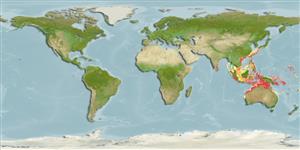Common names from other countries
Elasmobranquios (tiburones y rayas) (sharks and rays) >
Myliobatiformes (Stingrays) >
Dasyatidae (Stingrays) > Neotrygoninae
Etymology: australiae: Name referring to the Australasian distribution of this member of bluespotted mask ray complex.
of the genus Neotrygon..
Environment: milieu / climate zone / depth range / distribution range
Ecología
marino demersal; rango de profundidad 23 - 91 m (Ref. 116741). Tropical
Distribución
Países | Áreas FAO | Ecosistemas | Ocurrencias, apariciones | Point map | Introducciones | Faunafri
Eastern Indian Ocean to Western Pacific: Australia, Papua New Guinea and Indonesia.
Tamaño / Peso / Age
Maturity: Lm ? range ? - ? cm
Max length : 41.0 cm WD macho / no sexado; (Ref. 116741); 45.2 cm WD (female)
Short description
Claves de identificación | Morfología | Morfometría
This species of the kuhlii-complex (reaching at least 45 cm DW; males maturing at ca. 28 cm DW) is distinguished by the following set of characters: disc is much broader than long, width 1.2-1.3 times length; pectoral apices are narrowly angular; snout fleshy, broadly rounded to weakly angular, with angle 101-103°, length 1.6-2.1 times interorbital width; maximum width relatively well back on disc, length from snout tip to pectoral-fin insertion 1.7-1.8 times and disc width 2.3-2.5 times horizontal distance from snout tip to maximum disc width; preoral length 1.8-2.3 times the mouth width; internasal distance 1.3-1.6 in prenasal length; interspiracular distance 14-16% DW; nostril length 3.4-4% DW; nasal curtain width 8.4-9.1% DW; with small mouth, width 6.5-7.3% DW; horizontal distance from cloaca to the caudal sting base 42-52% of disc length; with thornlets in nuchal and lumbar regions in large individuals, none from tail in all sizes; no dermal denticles entirely from body; pectoral-fin radials 105-113; total vertebral centra (including synarcual) 129-134, trunk centra (including synarcual) 37-41; with large blue spots, the largest spot on disc 0.7-1.2 times eye width; 2-17 (mean 9.4) blue spots on medial belt, largest 3.3-5.6% DW; mask-like marking subtle, usually lightly covered with dark peppery spots (dark spots not widespread over central disc); the ventral surface of disc with distinct dark greyish brown submarginal bands; ventral tail fold is almost entirely dark (Ref. 116741).
A demersal fish found inshore to mid-continental ad insular shelves (Ref. 114953). Found over and adjacent to rocky and coral reefs from shallow water to at least 91 m depth (Ref. 116741).
Life cycle and mating behavior
Maturities | Reproducción | Spawnings | Egg(s) | Fecundities | Larva
Last, P.R., White, W.T. and B. Séret, 2016. Taxonomic status of maskrays of the Neotrygon kuhlii species complex (Myliobatoidei: Dasyatidae) with the description of three new species from the Indo-West Pacific. Zootaxa 4083(4):533-561. (Ref. 116741)
IUCN Red List Status (Ref. 130435)
CITES (Ref. 128078)
Not Evaluated
Threat to humans
Harmless
Human uses
Herramientas
Special reports
Download XML
Fuentes de Internet
Estimates based on models
Phylogenetic diversity index (Ref.
82804): PD
50 = 0.5039 [Uniqueness, from 0.5 = low to 2.0 = high].
Bayesian length-weight: a=0.01096 (0.00342 - 0.03513), b=3.11 (2.86 - 3.36), in cm Total Length, based on LWR estimates for this (Sub)family-body shape (Ref.
93245).
Nivel trófico (Ref.
69278): 3.4 ±0.3 se; based on size and trophs of closest relatives
Fishing Vulnerability (Ref.
59153): Moderate vulnerability (40 of 100).
